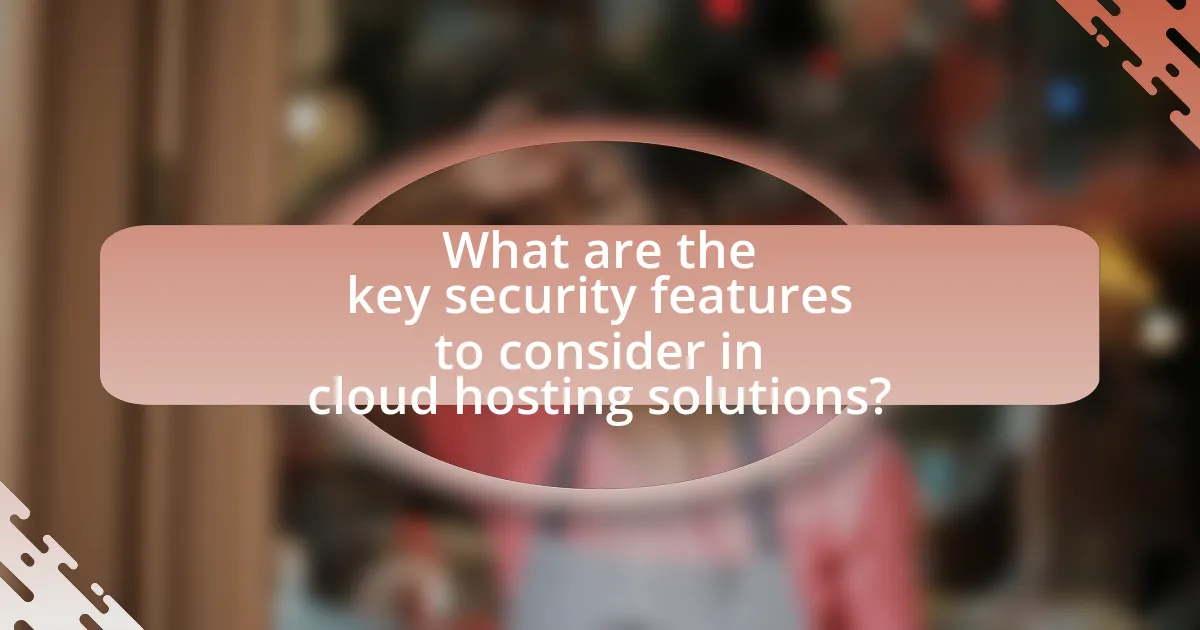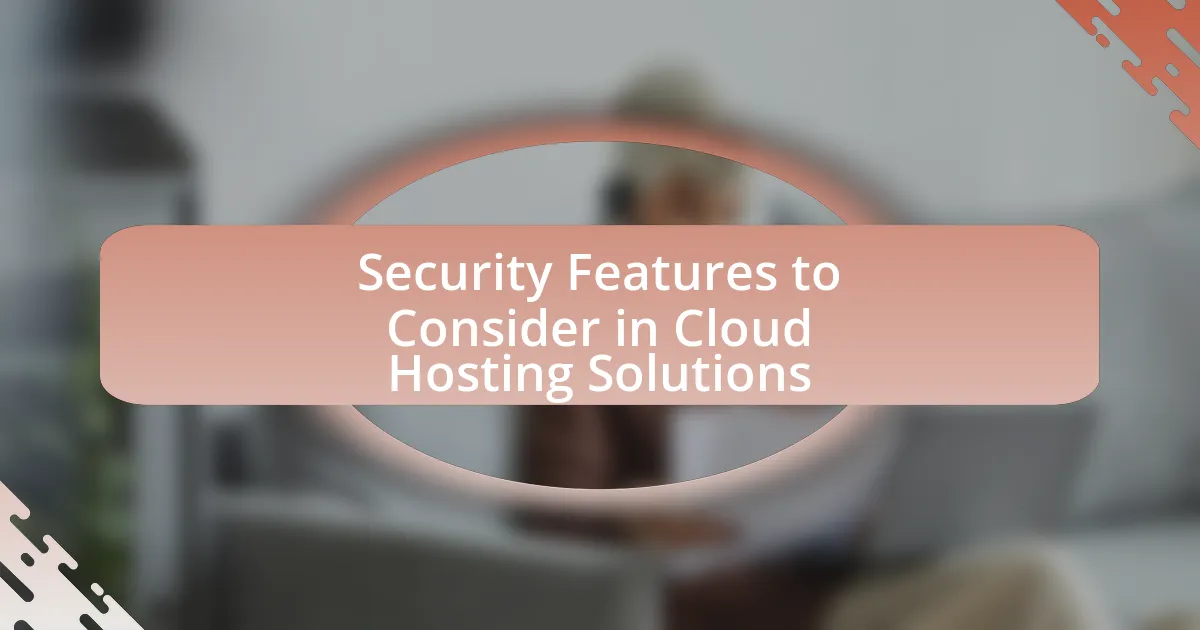The article focuses on the essential security features to consider in cloud hosting solutions, emphasizing the importance of data encryption, access controls, compliance certifications, and regular security audits. It explains how these features protect data by ensuring confidentiality and integrity, while also detailing the role of encryption and access control in preventing unauthorized access. Additionally, the article highlights the significance of compliance with industry standards and the common security threats faced by cloud hosting solutions, such as data breaches and DDoS attacks. It concludes with best practices for organizations to implement effective security measures, including the use of multi-factor authentication and regular security assessments.

What are the key security features to consider in cloud hosting solutions?
Key security features to consider in cloud hosting solutions include data encryption, access controls, compliance certifications, and regular security audits. Data encryption protects sensitive information both at rest and in transit, ensuring that unauthorized users cannot access it. Access controls, such as multi-factor authentication and role-based permissions, limit who can access data and applications, reducing the risk of breaches. Compliance certifications, like ISO 27001 and GDPR, demonstrate that the cloud provider adheres to industry standards for data protection. Regular security audits help identify vulnerabilities and ensure that security measures are effective and up-to-date. These features collectively enhance the security posture of cloud hosting solutions, making them more resilient against cyber threats.
How do these security features protect data in the cloud?
Security features protect data in the cloud by implementing encryption, access controls, and monitoring systems. Encryption secures data at rest and in transit, making it unreadable to unauthorized users. Access controls ensure that only authenticated and authorized individuals can access sensitive information, reducing the risk of data breaches. Monitoring systems track and log access and changes to data, enabling quick detection of suspicious activities. These measures collectively enhance data integrity and confidentiality, as evidenced by industry standards such as ISO/IEC 27001, which outlines best practices for information security management.
What role does encryption play in cloud security?
Encryption is essential in cloud security as it protects sensitive data from unauthorized access and breaches. By converting data into a coded format, encryption ensures that only authorized users with the correct decryption keys can access the information. According to a report by the Cloud Security Alliance, 95% of organizations that implement encryption experience a significant reduction in data breach risks. This statistic underscores the effectiveness of encryption in safeguarding data stored in cloud environments, making it a critical component of comprehensive cloud security strategies.
How does access control enhance security in cloud environments?
Access control enhances security in cloud environments by regulating who can access specific resources and data. By implementing role-based access control (RBAC) and least privilege principles, organizations can ensure that users only have the permissions necessary for their tasks, thereby minimizing the risk of unauthorized access. For instance, a study by the Cloud Security Alliance indicates that 74% of data breaches involve access control failures, highlighting the critical role of effective access management in preventing security incidents.
Why is compliance important in cloud hosting security?
Compliance is crucial in cloud hosting security because it ensures that organizations adhere to legal, regulatory, and industry standards that protect sensitive data. By following compliance frameworks such as GDPR, HIPAA, or PCI DSS, businesses mitigate risks associated with data breaches and unauthorized access. For instance, a study by the Ponemon Institute found that organizations with strong compliance programs experience 50% fewer data breaches compared to those without. This demonstrates that compliance not only safeguards data but also enhances trust with customers and partners, ultimately contributing to a more secure cloud hosting environment.
What are the major compliance standards relevant to cloud security?
The major compliance standards relevant to cloud security include the General Data Protection Regulation (GDPR), Health Insurance Portability and Accountability Act (HIPAA), Payment Card Industry Data Security Standard (PCI DSS), and Federal Risk and Authorization Management Program (FedRAMP). GDPR mandates data protection and privacy for individuals within the European Union, while HIPAA sets standards for protecting sensitive patient health information in the United States. PCI DSS outlines security measures for organizations that handle credit card information, and FedRAMP provides a standardized approach to security assessment for cloud services used by federal agencies. These standards are critical for ensuring data security and regulatory compliance in cloud environments.
How can organizations ensure compliance in their cloud hosting solutions?
Organizations can ensure compliance in their cloud hosting solutions by implementing robust governance frameworks and adhering to industry standards. This involves regularly assessing and updating security policies, conducting audits, and ensuring that data handling practices align with regulations such as GDPR or HIPAA. For instance, a study by the Cloud Security Alliance highlights that organizations that adopt a comprehensive compliance strategy experience a 30% reduction in security incidents. Additionally, utilizing cloud service providers that offer compliance certifications can further enhance adherence to legal and regulatory requirements.

What types of security threats do cloud hosting solutions face?
Cloud hosting solutions face several types of security threats, including data breaches, denial-of-service (DoS) attacks, and insecure APIs. Data breaches occur when unauthorized individuals gain access to sensitive information stored in the cloud, which can lead to significant financial and reputational damage for organizations. According to a report by IBM, the average cost of a data breach in 2021 was $4.24 million, highlighting the financial impact of such incidents. Denial-of-service attacks aim to overwhelm cloud services, rendering them unavailable to legitimate users, which can disrupt business operations. Insecure APIs can expose cloud services to vulnerabilities, allowing attackers to exploit weaknesses and gain unauthorized access. These threats underscore the importance of implementing robust security measures in cloud hosting solutions.
How do data breaches occur in cloud environments?
Data breaches in cloud environments occur primarily due to vulnerabilities in security configurations, inadequate access controls, and human error. Misconfigured cloud settings can expose sensitive data to unauthorized users, as evidenced by the 2019 Capital One breach, where a misconfigured web application firewall led to the exposure of over 100 million customer records. Additionally, weak access controls can allow attackers to gain unauthorized access, while human error, such as accidentally sharing sensitive information, further increases the risk of breaches. These factors highlight the critical need for robust security measures in cloud hosting solutions.
What are the common causes of data breaches in cloud hosting?
Common causes of data breaches in cloud hosting include misconfigured cloud settings, inadequate access controls, and vulnerabilities in third-party applications. Misconfigured settings can expose sensitive data, as evidenced by the 2019 Capital One breach, where a misconfigured firewall allowed unauthorized access to over 100 million accounts. Inadequate access controls, such as weak passwords or lack of multi-factor authentication, can lead to unauthorized access, as highlighted by the 2020 Twitter breach, where attackers exploited weak security measures. Additionally, vulnerabilities in third-party applications can serve as entry points for attackers, as seen in the 2021 SolarWinds attack, which compromised numerous organizations through a single software vulnerability.
How can organizations mitigate the risk of data breaches?
Organizations can mitigate the risk of data breaches by implementing robust security measures, including encryption, access controls, and regular security audits. Encryption protects sensitive data both at rest and in transit, making it unreadable to unauthorized users. Access controls ensure that only authorized personnel can access critical information, reducing the likelihood of insider threats. Regular security audits help identify vulnerabilities and ensure compliance with industry standards, such as the General Data Protection Regulation (GDPR), which mandates strict data protection measures. According to a 2020 report by IBM, organizations that adopt comprehensive security strategies can reduce the average cost of a data breach by approximately $1.4 million.
What is the impact of DDoS attacks on cloud hosting security?
DDoS attacks significantly compromise cloud hosting security by overwhelming resources, leading to service outages and degraded performance. These attacks exploit the distributed nature of cloud environments, making it challenging for providers to mitigate the impact effectively. According to a report by the cybersecurity firm Akamai, DDoS attacks increased by 15% in 2020, highlighting the growing threat to cloud services. The inability to maintain service availability during such attacks can result in financial losses, reputational damage, and loss of customer trust for businesses relying on cloud hosting solutions.
How can cloud providers defend against DDoS attacks?
Cloud providers can defend against DDoS attacks by implementing a combination of traffic filtering, rate limiting, and scalable infrastructure. Traffic filtering allows providers to identify and block malicious traffic before it reaches the target server, while rate limiting restricts the number of requests a user can make in a given timeframe, mitigating the impact of an attack. Additionally, scalable infrastructure enables cloud providers to absorb and distribute large volumes of traffic across multiple servers, reducing the likelihood of service disruption. According to a report by Akamai, companies that utilize these strategies can reduce the impact of DDoS attacks by up to 90%, demonstrating the effectiveness of these defensive measures.
What measures can users take to protect their cloud resources from DDoS attacks?
Users can protect their cloud resources from DDoS attacks by implementing a combination of strategies, including using DDoS protection services, employing traffic filtering, and leveraging content delivery networks (CDNs). DDoS protection services, such as those offered by cloud providers, can detect and mitigate attacks in real-time, ensuring that legitimate traffic is prioritized. Traffic filtering allows users to set rules that block malicious traffic based on specific characteristics, such as IP addresses or request patterns. Additionally, CDNs can distribute traffic across multiple servers, reducing the impact of an attack on any single resource. According to a report by the Cybersecurity and Infrastructure Security Agency, organizations that utilize these measures can significantly reduce their vulnerability to DDoS attacks, enhancing the overall security of their cloud infrastructure.

How can organizations implement effective security measures in cloud hosting?
Organizations can implement effective security measures in cloud hosting by adopting a multi-layered security approach that includes data encryption, access controls, and regular security audits. Data encryption protects sensitive information both at rest and in transit, ensuring that unauthorized users cannot access it. Access controls, such as role-based access and multi-factor authentication, limit user permissions and enhance security by requiring additional verification steps. Regular security audits help identify vulnerabilities and ensure compliance with industry standards, thereby reinforcing the overall security posture. According to a 2021 report by the Cloud Security Alliance, organizations that implement these measures significantly reduce their risk of data breaches and enhance their cloud security effectiveness.
What best practices should organizations follow for cloud security?
Organizations should implement multi-factor authentication (MFA) as a best practice for cloud security. MFA significantly enhances security by requiring users to provide two or more verification factors to gain access to cloud services, reducing the risk of unauthorized access. According to a study by Microsoft, MFA can block over 99.9% of account compromise attacks. Additionally, organizations should regularly conduct security assessments and audits to identify vulnerabilities in their cloud infrastructure. This proactive approach helps in mitigating risks before they can be exploited. Furthermore, data encryption both at rest and in transit is essential, as it protects sensitive information from unauthorized access and breaches. The 2021 Verizon Data Breach Investigations Report highlighted that 61% of breaches involved credential data, underscoring the importance of robust security measures like MFA and encryption.
How can regular security audits improve cloud security?
Regular security audits enhance cloud security by identifying vulnerabilities and ensuring compliance with security policies. These audits systematically evaluate cloud infrastructure, applications, and data management practices, allowing organizations to detect weaknesses before they can be exploited by malicious actors. For instance, a study by the Cloud Security Alliance found that organizations conducting regular audits experienced a 30% reduction in security incidents compared to those that did not. This proactive approach not only mitigates risks but also fosters a culture of security awareness within the organization, ultimately leading to stronger overall cloud security.
What role does employee training play in maintaining cloud security?
Employee training plays a critical role in maintaining cloud security by equipping staff with the knowledge and skills necessary to identify and mitigate security threats. Trained employees are more likely to recognize phishing attempts, adhere to security protocols, and understand the importance of data protection measures. According to a report by IBM, organizations with a strong security awareness training program can reduce the risk of a data breach by up to 70%. This highlights the effectiveness of training in fostering a security-conscious culture, ultimately leading to enhanced cloud security.
What tools and technologies can enhance cloud security?
Tools and technologies that can enhance cloud security include encryption, identity and access management (IAM), firewalls, intrusion detection systems (IDS), and security information and event management (SIEM) solutions. Encryption protects data at rest and in transit, ensuring that unauthorized users cannot access sensitive information. IAM solutions manage user identities and permissions, reducing the risk of unauthorized access. Firewalls act as barriers between trusted and untrusted networks, while IDS monitor network traffic for suspicious activities. SIEM solutions aggregate and analyze security data from various sources, enabling organizations to detect and respond to threats in real-time. These tools collectively strengthen cloud security by addressing various vulnerabilities and enhancing overall protection.
How do firewalls and intrusion detection systems protect cloud environments?
Firewalls and intrusion detection systems (IDS) protect cloud environments by monitoring and controlling incoming and outgoing network traffic based on predetermined security rules. Firewalls act as a barrier between trusted internal networks and untrusted external networks, filtering traffic to prevent unauthorized access and attacks. For instance, they can block malicious traffic and enforce policies that restrict access to sensitive data.
Intrusion detection systems complement firewalls by continuously monitoring network traffic for suspicious activities and potential threats. They analyze patterns and behaviors to identify anomalies that may indicate a security breach. According to a report by the Ponemon Institute, organizations that implement IDS can reduce the average time to detect a breach by 50%, significantly minimizing potential damage.
Together, firewalls and IDS create a multi-layered security approach that enhances the overall protection of cloud environments, ensuring that sensitive data remains secure against various cyber threats.
What are the benefits of using multi-factor authentication in cloud security?
Multi-factor authentication (MFA) enhances cloud security by requiring multiple forms of verification before granting access to sensitive data. This additional layer significantly reduces the risk of unauthorized access, as it is not enough for an attacker to simply obtain a password. According to a report by Microsoft, MFA can block over 99.9% of account compromise attacks, demonstrating its effectiveness in protecting cloud environments. By implementing MFA, organizations can safeguard their data against phishing, credential theft, and other cyber threats, thereby ensuring a more secure cloud infrastructure.
What are the common troubleshooting steps for cloud security issues?
Common troubleshooting steps for cloud security issues include verifying access controls, reviewing security logs, assessing network configurations, and updating security policies. Verifying access controls ensures that only authorized users have access to sensitive data, which is crucial for preventing unauthorized access. Reviewing security logs helps identify any suspicious activities or breaches, allowing for timely responses. Assessing network configurations ensures that firewalls and security groups are correctly set up to protect against external threats. Updating security policies is essential to adapt to evolving threats and compliance requirements, ensuring that security measures remain effective. These steps are foundational in maintaining robust cloud security and mitigating risks.

